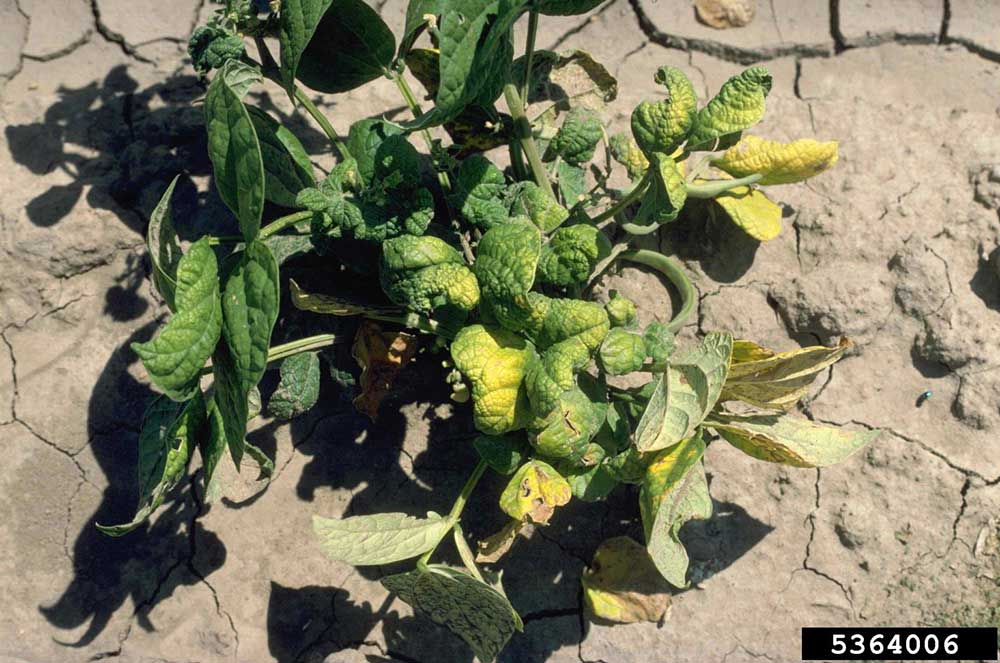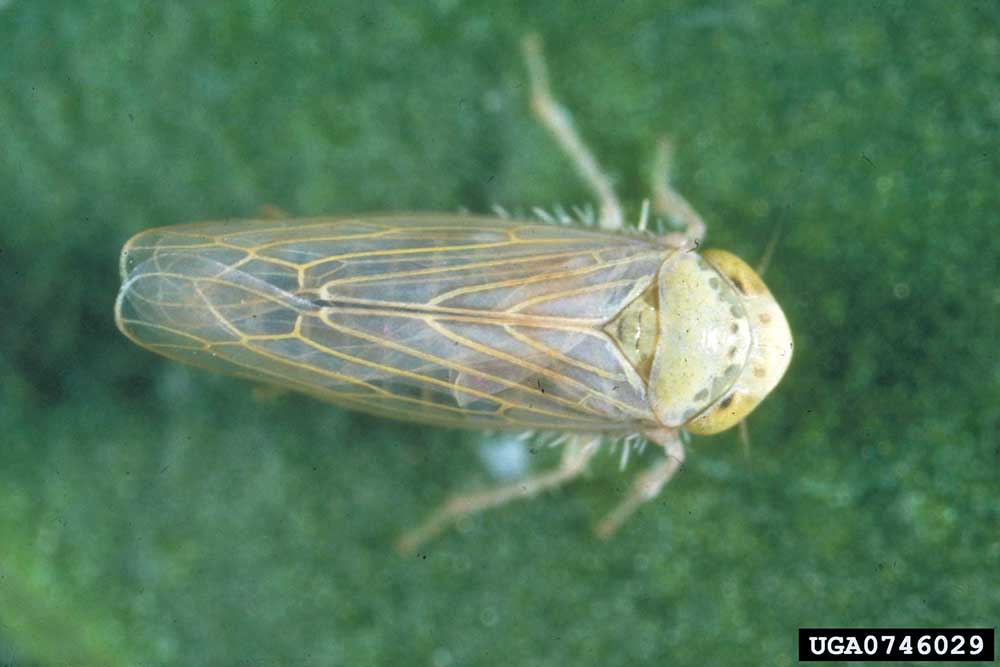Curly top is a viral disease of plants most commonly found in the Western United States. The disease is of concern to growers, as it infects many major agricultural crops, including tomatoes, beets, beans, spinach, peppers, and cucurbits. Plants infected with curly top exhibit stunted, as well as twisting and curling of leaves and fruit. More than 300 species of plants in 44 families are known to be susceptible to this disease, which is caused by the beet curly top virus.
Curly top the disease causes profound deformation of plant leaves and fruits, and ultimately kills infected plants.
The symptoms of curly top can vary depending on the species of plant. But in most cases, leaves will begin to curl and twist. Sometimes they become discolored, taking on a light green or yellow color, with veins on the undersides of leaves becoming purple. As the disease progresses, plants will become increasingly twisted and distorted. The overall coloration will take on a yellowish hue, and growth will be stunted.

The age of the plant when infection occurs can have a significant impact on symptomology. Plants that are younger when infected may die quite quickly. On the other hand, older plants may show only limited signs of curling and yellowing on newer leaves and shoots. But even with older plants, there is a major impact on yields, as fruits are stunted, ripening prematurely. The effects on fruits vary by species. For instance, unripe tomatoes will redden prematurely.
Curly top is often misdiagnosed early on, as the initial symptoms of the disease are similar to the consequences of heat stress and underwatering. But it’s quite easy to determine whether water issues are to blame: heavily water a potentially infected plant and see how it looks the next morning. If wilting has not diminished, it may be curly top, though genetic testing is necessary for making a positive diagnosis.

Curly top is caused by the beet curly top virus or one of several related viruses, and is transmitted via the beet leafhopper.
Curly top is caused several interrelated viruses, including:
- Beet curly top virus (BCTV)
- Beet mild curly top virus (BMCTV)
- Beet severe curly top virus (BSCTV)
- Horseradish curly top virus (HrCTV)
- Pepper curly top virus (PeCT)
- Pepper yellow dwarf (PeYD)
- Spinach curly top virus (SpCT)
- Spinach severe curly top virus (SpSCTV)
- Turnip curly top virus
It was previously believed that each of these viruses were a unique species of Curtovirus, a genus of viruses transmitted solely by various species of leafhoppers. However, gene sequencing has revealed that most of these viruses are strains of beet curly top virus (BCTV).
It should also be pointed out that BCTV and its relatives are not particularly picky. It would be easy to assume that curly top in peppers is caused by pepper curly top virus, and so on, with each vulnerable plant species being infected by its corresponding strain of the curly top virus. This isn’t the case. BCTV is known to infect most plants susceptible to curly tops. Even the various strains can cross species. For instance, spinach plants are susceptible to BCTV as well as pepper curly top virus.
Regardless of the strain, there is a single vector for curly top in the United States: the beet leafhopper, Circulifer tenellus (also known as (Neoaliturus tenellus)Found throughout much of the Western United States, beet leafhoppers are winged insects that are yellow or olive in color, measuring about one-eighth of an inch at adulthood. Named for their habit of hopping away when disturbed, leafhoppers feed on plants by using their piercing mouthparts to penetrate leaves and stems.

Leafhoppers pick up the virus by feeding on infected plant. The virus moves through the insect’s gut, and then into the salivary glands. When an infected insect subsequently feeds on another plant, saliva carrying the virus passes into the plant (similar to how mosquitos can transmit a variety of diseases to humans). Testing has shown that leafhoppers can transmit the curly top virus only an hour after feeding on an infected plant, and can retain the virus in their guts for up to a month. Given this, it’s easy to see how the disease can spread explosively from even a single infected plant.
There is no cure for the curly top virus, and controlling the spread of beet leafhopper populations is quite difficult. Leafhoppers reproduce very quickly, and the warmer the weather, the faster they reproduce. In ideal lab conditions, leafhoppers have been observed to produce up to 16 generations in a single year, though in real world conditions, at best the maximum number of generations is about eight per year.
The explosive rates at which leafhoppers can reproduce, as well as the insect’s ability and willingness to migrate up to 500 miles, mean that insecticidal treatments often have very limited effectiveness. Though a local population may be eradicated, populations elsewhere will quickly expand back into the unexploited ecological niche left behind.
Because of the above, one of the best means of preventing the spread of the disease is to discourage leafhopper feeding by installing shade cloth coverings. Beet leafhoppers prefer to feed in full sun, and dislike shady areas. In areas where curly top disease is especially common, more aggressive approaches, such as denser planting of crops and extensive use of shading, has proven to be reasonably effective.
It is advisable to remove any plants that you believe to be infected by curly top. Leaving an infected plant in place will simply provide a vector for the virus to spread from. Be sure to remove all infected plant debris, and dispose of or burn infected debris.




